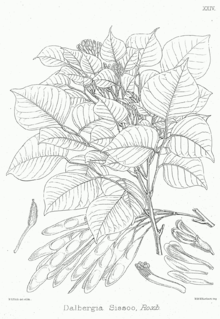Dalbergia
| Dalbergia | |
|---|---|
 |
|
| Sissoo or Indian Rosewood (Dalbergia sissoo) | |
| Scientific classification | |
| Kingdom: | Plantae |
| (unranked): | Angiosperms |
| (unranked): | Eudicots |
| (unranked): | Rosids |
| Order: | Fabales |
| Family: | Fabaceae |
| Subfamily: | Faboideae |
| Tribe: | Dalbergieae |
| Genus: |
Dalbergia L.f. |
| Species | |
|
275; see text. |
|
| Synonyms | |
|
|
275; see text.
Dalbergia is a large genus of small to medium-size trees, shrubs and lianas in the pea family, Fabaceae, subfamily Faboideae. It was recently assigned to the informal monophyletic Dalbergia clade of the Dalbergieae. The genus has a wide distribution, native to the tropical regions of Central and South America, Africa, Madagascar and southern Asia.
A fossil Dalbergia phleboptera pod has been recovered from the stage Chattian of the Oligocene epoch in the municipality of Aix-en-Provence in France. Fossils of Dalbergia nostratum have been recovered from rhyodacite tuff of Lower Miocene age in Southern Slovakia near the town of Lučenec.
Many species of Dalbergia are important timber trees, valued for their decorative and often fragrant wood, rich in aromatic oils. The most famous of these are the rosewoods, so-named because of the smell of the timber when cut, but several other valuable woods are yielded by the genus.
The pre-eminent rosewood appreciated in the western world is D. nigra known as Rio, Bahia, Brazilian Rosewood, Palisander de Rio Grande, or Jacarandá; heavily exploited in the past, it is now listed on CITES Appendix I. The second most desired rosewood in the western world is D. latifolia known as (East) Indian Rosewood or Sonokeling. Most rosewoods are a rich brown with a good figure. Note that only a small number of Dalbergia species yield rosewood. Several East Asian species are important materials in traditional Chinese furniture.
...
Wikipedia
